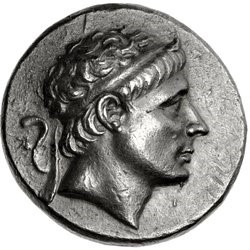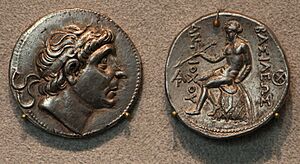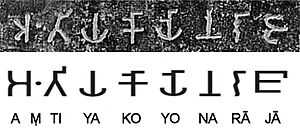Antiochus II Theos facts for kids
Quick facts for kids Antiochus II Theos |
|
|---|---|
| Basileus | |

Silver tetradrachm of Antiochus II Theos, minted in Tarsus, featuring a portrait of Antiochus on the obverse. SC 561
|
|
| Basileus of the Seleucid Empire | |
| Reign | 2 June 261 – July 246 BC |
| Predecessor | Antiochus I Soter |
| Successor | Seleucus II Callinicus |
| Born | 286 BC Syria |
| Died | early July 246 BC (aged 39–40) Asia Minor (modern-day Turkey) |
| Spouse | Laodice I Berenice |
| Issue | with Laodice: Seleucus II Callinicus Antiochus Hierax Apama Stratonice of Cappadocia Laodice with Berenice: Antiochus |
| Dynasty | Seleucid dynasty |
| Father | Antiochus I Soter |
| Mother | Stratonice of Syria |
| Religion | Greek polytheism |
Antiochus II Theos (born 286 BC, died July 246 BC) was a Greek king. He ruled the Seleucid Empire from 261 to 246 BC. This empire was a large kingdom formed after the death of Alexander the Great. Antiochus II took over from his father, Antiochus I Soter. He was the younger son of Antiochus I and Queen Stratonice of Syria.
Antiochus II was a strong leader. He mostly managed to keep his huge empire together. However, he made a big decision that caused problems later. He ended his first marriage to Laodice I to marry Berenice, an Egyptian princess. This was part of a peace deal. After his death, this led to a fight over who would be the next king. This struggle greatly weakened the empire and caused it to lose much land.
Contents
Becoming King
Antiochus II was not originally expected to become king. He was the younger son of Antiochus I Soter and Queen Stratonice of Syria. But in 267 BC, his older brother, Seleucus, was removed from the line of succession. This made Antiochus the next in line for the throne.
Antiochus II's Reign
When Antiochus II became king, there were already problems with Ptolemaic Egypt. This was another powerful kingdom in the region. He soon started the Second Syrian War with Egypt. He teamed up with Antigonus II, the king of Antigonid Macedon.
Battles and Gains
The war mainly happened along the coast of Anatolia (modern-day Turkey). Antiochus II gained some land there. He took control of cities like Miletus and Ephesus. This gave his empire direct access to the Aegean Sea. During this war, the people of Miletus gave him the title Theos. This Greek word means "God." They called him this because he helped them by defeating a harsh ruler named Timarchus of Miletus. Antiochus II also tried to gain a foothold in Thrace, but not much is known about this effort.
Peace Treaty and Marriages
The war didn't change the power balance much. Coele-Syria, a key area, stayed with Egypt. In 257 BC, the Egyptian pharaoh, Ptolemy II Philadelphus, even invaded part of Syria. In 253 BC, Antiochus II made peace with Ptolemy II. As part of the peace deal, Antiochus II divorced his wife, Laodice I. He then married Ptolemy II's daughter, Berenice. The agreement was that any children from this new marriage would become the next rulers.
Laodice was given many gifts and lands after the divorce. She received large estates in areas like the Dardanelles, Cyzicus, and Caria. She also got money from different territories and didn't have to pay some taxes. Even after the divorce, Laodice remained a very powerful and important person. She continued to try and regain her position as queen.
A King's Sudden Death
By 246 BC, Antiochus II left Berenice and their young son in Antioch. He went back to live with Laodice in Asia Minor. This might have happened after he heard that Ptolemy II had died. Antiochus II died suddenly soon after. Many people believed that Laodice was involved in his death. He was buried in the Belevi Mausoleum.
The Fight for the Throne
After Antiochus II's death, a big fight for the throne began. Berenice was in Antioch with her young son. Meanwhile, Laodice announced that her oldest son, Seleucus, was the new king. She claimed that Antiochus II had changed his mind before he died and named Seleucus as his successor.
Berenice's brother, Ptolemy III, who was the king of Egypt, marched to support his sister. But when he arrived, Berenice and her son had sadly died during the conflict. Ptolemy III was very angry and continued the war. This conflict is known as the Third Syrian War. It was a very difficult time for the Seleucid Empire.
Eastern Regions of the Empire
Not much is known about what Antiochus II did in the eastern parts of his empire. These areas included Media, Parthia, and Bactria. He was very busy with conflicts in the Mediterranean and family issues. So, he seemed to appoint strong, independent leaders to govern these distant regions.
These leaders, like Diodotus I and Andragoras, eventually created their own independent kingdoms. These were the Greco-Bactrian Kingdom and the Parthian Empire. This shows that the central government's control over these far-off areas was weakening.
Possible Connection to India
An Antiochus is mentioned in the Edicts of Ashoka. These are ancient writings from the Indian Emperor Ashoka. They talk about Ashoka's efforts to spread Buddhism. Most historians believe that the Greek king mentioned there is actually Antiochus II's father, Antiochus I Soter. This is because Antiochus I had closer ties to the East.



